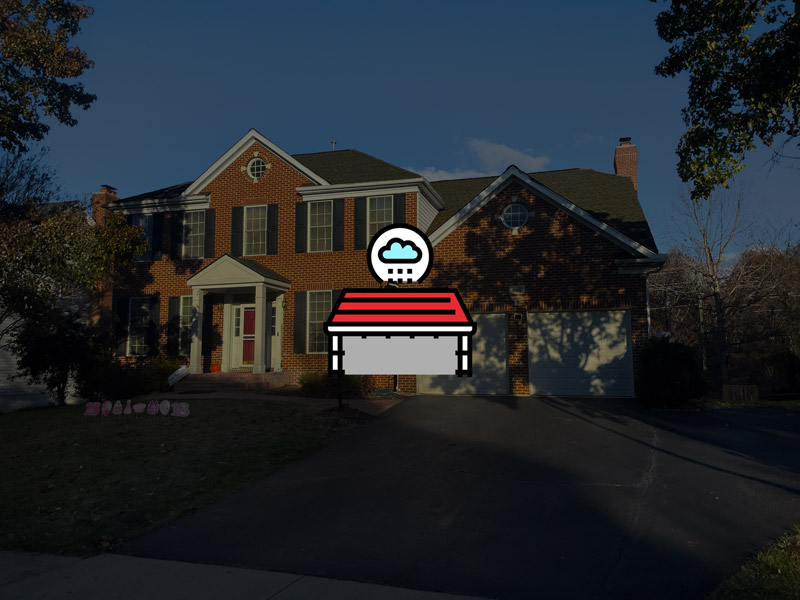Skylight Leaks When It Rains: Prevention and Solutions
Unfortunately, one of the common problems associated with skylights is the occurrence of leaks when it rains. These leaks can lead to various issues, such as water damage, mold growth, and compromised structural integrity. Understanding the causes behind skylight leaks and finding effective solutions is crucial for maintaining a leak-free and secure roofing system.

Causes and Common Problems
Overview of Potential Causes for Skylight Leaks
Skylight leaks during rainfall can occur due to several factors. Understanding these causes is crucial for effectively addressing and preventing the issue. Common causes include:
- Faulty Installation: Improper installation of skylights can lead to gaps or inadequate sealing, allowing water to infiltrate during rainfall.
- Poor Maintenance: Neglecting regular maintenance of skylights, such as cleaning debris or checking for damaged seals, can contribute to leaks over time.
- Weathering: Exposure to harsh weather conditions, including extreme temperatures, UV rays, and heavy rain, can degrade the materials and seals of skylights, leading to potential leaks.
- Aging Materials: Over time, the materials used in skylights, such as seals and flashing, can deteriorate, increasing the likelihood of leaks during rainfall.
Identifying Common Issues Contributing to Leaks
To effectively address skylight leaks when it rains, it is essential to identify the common issues that contribute to the problem. Some of these issues include:
- Sealant Failure: If the sealant used around the skylight becomes damaged or deteriorates, it can allow water to penetrate the roofing system.
- Improper Flashing: Inadequate or incorrect installation of flashing around the skylight can create gaps or weak points where water can seep in.
- Condensation: Improper insulation or ventilation can cause condensation to form on the skylight, leading to moisture buildup and potential leaks.
Importance of Timely Detection and Addressing Leaks
Timely detection and addressing of skylight leaks are crucial to prevent further damage and maintain the integrity of your roofing system. Ignoring leaks can result in more significant issues, such as water damage, mold growth, and compromised structural stability. Regular inspections, proactive maintenance, and prompt repairs are vital to mitigate the risk of leaks and minimize potential long-term consequences.

Understanding TPO Roofing Systems
Introduction to TPO (Thermoplastic Olefin) Roofing
TPO roofing is a popular option for both residential and commercial buildings due to its excellent performance and cost-effectiveness. Made from a blend of rubber and plastic, TPO membranes provide a durable and flexible solution for skylight leaks when it rains.
Key Characteristics and Benefits of TPO Roofing
- Durability: TPO roofing is highly resistant to tears, punctures, and impacts, making it a reliable choice for withstanding the elements, including heavy rain and hailstorms.
- Energy Efficiency: TPO roofs are designed to reflect sunlight, reducing heat absorption and lowering cooling costs during hot weather. This energy-efficient characteristic contributes to the overall sustainability of the building.
- Flexibility: TPO membranes exhibit flexibility, allowing them to accommodate the movement of the building’s structure and potential thermal expansion and contraction without compromising their integrity.
Cost Considerations: TPO Roofing Installation, Maintenance, and Lifespan
TPO roofing systems offer a cost-effective solution for preventing skylight leaks. The installation costs of TPO roofing are typically lower than other roofing materials, making it an attractive option for budget-conscious individuals or businesses.
Additionally, TPO roofs require minimal maintenance, reducing long-term expenses. Regular inspections and basic upkeep, such as removing debris and ensuring proper drainage, can help maintain the roof’s performance and prevent leaks during rainfall.
In terms of lifespan, TPO roofs can last anywhere from 15 to 30 years, depending on various factors such as installation quality, weather conditions, and maintenance practices. Proper installation by experienced professionals and routine inspections can help maximize the lifespan of TPO roofing systems.
How TPO Roofing Can Help Prevent Skylight Leaks When It Rains
TPO roofing provides a reliable barrier against skylight leaks when it rains. The thermoplastic material and welded seams create a seamless and watertight membrane, minimizing the risk of water infiltration.
When combined with proper flashing installation and regular maintenance, TPO roofing systems can effectively prevent skylight leaks, ensuring a dry and secure environment even during heavy rainfall.

PVC Roofing Systems: An Alternative Solution
Exploring PVC (Polyvinyl Chloride) Roofing Systems
PVC roofing systems offer an alternative solution for addressing skylight leaks when it rains. PVC, a synthetic plastic material, provides several benefits and features that make it a popular choice among homeowners and businesses.
Advantages of PVC Roofing
UV Resistance: PVC roofs are designed to withstand prolonged exposure to the sun’s ultraviolet (UV) rays without significant degradation. This UV resistance ensures that the roofing material remains durable and intact, minimizing the risk of skylight leaks.
- Chemical Stability: PVC is highly resistant to chemicals, including acids, oils, and pollutants, making it suitable for areas with potential exposure to such substances. This chemical stability further enhances the roof’s longevity and leak prevention capabilities.
- Fire Resistance: PVC roofing systems possess inherent fire-resistant properties. They have a high ignition point and are self-extinguishing, reducing the risk of fire-related incidents and providing an added layer of safety for the structure.
Comparing the Cost Factors: PVC Roofing Installation, Maintenance, and Lifespan
When considering PVC roofing systems, it is essential to evaluate the cost factors associated with installation, maintenance, and lifespan. While PVC roofs may have a higher upfront installation cost compared to other roofing materials, their long-term benefits often outweigh the initial investment.
PVC roofs require minimal maintenance, contributing to cost savings over time. Routine inspections, cleaning, and ensuring proper drainage can help maintain the roof’s performance and extend its lifespan.
Speaking of longevity, PVC roofs typically have a lifespan of 20 to 30 years, depending on factors such as installation quality and maintenance practices. This extended lifespan contributes to their ability to effectively address skylight leaks during rainfall for an extended period.
How PVC Roofing Can Address Skylight Leaks Effectively During Rainfall
PVC roofing systems are engineered to provide excellent waterproofing capabilities, making them highly effective in preventing skylight leaks when it rains. The PVC membranes are heat-welded at the seams, creating a seamless and watertight barrier.
This watertight seal, combined with the inherent properties of PVC, ensures that the roofing system remains impervious to water infiltration even during heavy rainfall. Proper installation, including the integration of flashing around skylights, further enhances the leak prevention capabilities of PVC roofs.

Factors to Consider: Choosing Between TPO and PVC Roofing
Assessing the Specific Needs and Requirements of Your Skylight Project
Before deciding between TPO and PVC roofing systems to address skylight leaks when it rains, it is crucial to assess your specific needs and project requirements. Consider factors such as the climate in your region, the age and condition of your current roof, and the extent of skylight leaks. Understanding these elements will help you make an informed decision and choose the most suitable solution.
Comparative Analysis of TPO and PVC Roofing Systems
Performing a comparative analysis of TPO and PVC roofing systems can aid in determining the best fit for your skylight leak prevention needs. Consider the following aspects:
- Performance: Evaluate the performance characteristics of TPO and PVC roofing systems in terms of their ability to withstand harsh weather conditions and effectively prevent skylight leaks.
- Longevity: Compare the expected lifespan of TPO and PVC roofs to ensure long-term durability and leak resistance.
- Maintenance: Assess the maintenance requirements of both roofing systems, including the frequency of inspections, cleaning, and repairs.
Cost Considerations: Initial Investment, Long-Term Savings, and Return on Investment (ROI)
When comparing TPO and PVC roofing systems, consider the cost factors associated with each option. Evaluate the initial investment required for installation, including materials and labor. Additionally, assess the long-term savings potential, such as energy efficiency and reduced maintenance expenses. Calculate the return on investment (ROI) over the expected lifespan of the chosen roofing system.
Consulting with Roofing Professionals to Determine the Best Solution for Skylight Leaks
Seeking advice from roofing professionals is invaluable when deciding between TPO and PVC roofing systems. Their expertise and experience can provide valuable insights tailored to your specific skylight leak concerns. Professional roofers can assess your existing roof, analyze the extent of the leaks, and recommend the most suitable solution for long-lasting leak prevention.

When to Replace the Roof: Age and Maintenance Considerations
The Importance of Regular Roof Inspections and Maintenance
Regular roof inspections and maintenance play a vital role in preventing skylight leaks when it rains. Routine inspections by qualified professionals allow for the early detection of potential issues, including deteriorating materials or damaged seals around skylights. Timely maintenance, such as clearing debris and ensuring proper drainage, can significantly extend the lifespan of the roof and minimize the risk of leaks.
Signs Indicating the Need for Roof Replacement
Several signs may indicate the need for roof replacement to prevent skylight leaks when it rains:
- Extensive Leaks: If skylight leaks persist even after repairs or if multiple leaks occur throughout the roof, it may be a sign that the roof has reached the end of its lifespan.
- Significant Damage: Severe storm damage, such as missing or broken shingles, can compromise the roof’s integrity and increase the risk of leaks during rainfall.
- Aging Materials: Over time, roofing materials deteriorate due to exposure to the elements. Cracked or curling shingles, brittle flashing, or worn-out seals around skylights are indicators of aging materials that may necessitate roof replacement.
Factors to Consider When Determining the Lifespan of a Roof
Several factors contribute to the lifespan of a roof and should be considered when determining whether replacement is necessary:
- Material Quality: The quality of the roofing material used during installation influences its durability and longevity. Higher-quality materials typically offer longer lifespans.
- Climate: Harsh weather conditions, such as heavy rain, strong winds, or extreme temperatures, can accelerate roof deterioration. Consider the impact of the climate in your region on the lifespan of your roof.
- Maintenance: Regular maintenance and timely repairs can significantly extend the lifespan of a roof. Neglected maintenance can shorten the roof’s life expectancy and increase the risk of leaks.
Expert Recommendations for When to Replace a Roof to Prevent Skylight Leaks and Ensure Overall Roof Integrity
Roofing professionals recommend considering the following factors to determine the ideal time for roof replacement:
- Age: Most roofs have an average lifespan of 20 to 25 years. If your roof is approaching or surpassing this age range, it is prudent to consider replacing it to proactively prevent skylight leaks and maintain overall roof integrity.
- Extensive Damage: If the roof has sustained extensive damage or has reached a point where repairs are frequent and costly, replacement becomes a more viable and cost-effective option.
- Professional Assessment: Consulting with roofing experts who can assess the condition of your roof and provide personalized recommendations based on their expertise is crucial. They can evaluate the extent of skylight leaks, overall roof health, and the urgency of replacement.
View More Articles
Please Share!











